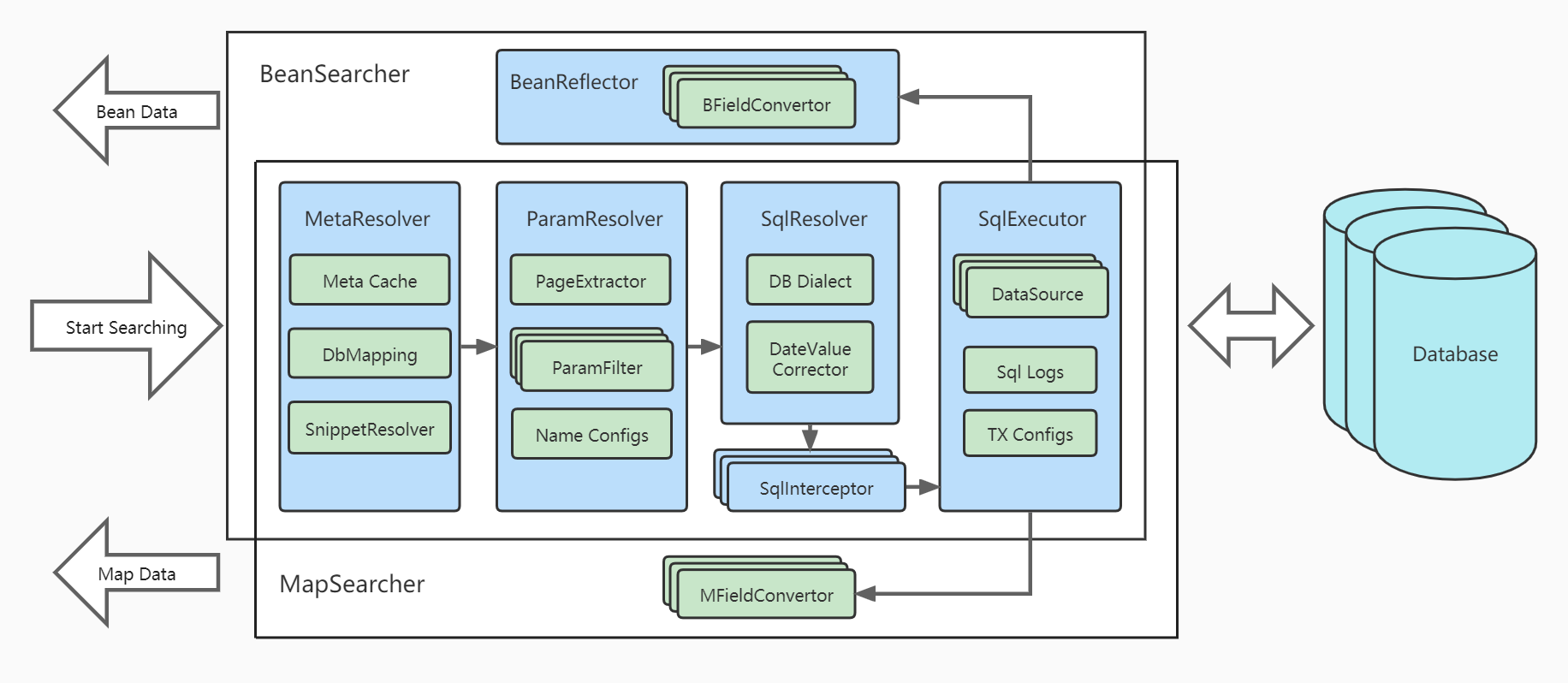Bean Searcher
Bean Searcher is a lightweight database conditional retrieval engine. Its function is to retrieve data from existing database tables. Its purpose is to reduce the development of backend template code, greatly improve development efficiency, and save development time, making it possible to complete a list query interface with just one line of code!
- It does not depend on a specific Web framework (i.e., it can be used in any Java Web framework).
- It does not depend on a specific ORM framework (i.e., it can be used in conjunction with any ORM framework and can also be used independently without an ORM).
Framework Introduction
Architecture Design Diagram

Differences from Hibernate and MyBatis
First of all, Bean Searcher is not a complete ORM framework. Its purpose is not to replace them but to make up for their deficiencies in the list retrieval field.
The following table lists the specific differences between them:
| Difference Point | Bean Searcher | Hibernate | MyBatis |
|---|---|---|---|
| ORM | Read-only ORM | Fully automatic ORM | Semi-automatic ORM |
| Entity classes can be mapped to multiple tables | Supported | Not supported | Not supported |
| Field operators | Dynamic | Static | Static |
| CRUD | Only R | CRUD | CRUD |
As can be seen from the above table, Bean Searcher can only perform database queries and does not support create, update, and delete operations. However, its multi-table mapping mechanism and dynamic field operators can make our code ten times more efficient, or even a hundred times more efficient when performing complex list retrievals.
More importantly, it has no third-party dependencies and can be used in conjunction with any ORM in the project.
Which projects can use it
- Java projects (of course, Kotlin and Gradle projects are also acceptable);
- Projects that use relational databases (e.g., MySQL, Oracle, etc.);
- It can be integrated with any framework: Spring Boot, Grails, JFinal, etc.
When to use it
Every framework has its own usage scenarios. Of course, Bean Searcher is no exception. Its emergence is not to replace traditional ORMs such as MyBatis or Hibernate. Therefore, it is very important to understand which scenarios are suitable for using it.
- It is recommended to use it in non-transactional and dynamic retrieval scenarios. For example: In the retrieval scenarios of pages such as [Order Management] and [User Management] in the management background, the retrieval is non-transactional and does not insert data into the database. Moreover, the retrieval conditions are dynamic. Different user retrieval methods result in different executed SQL statements (e.g., retrieving by
order numberand retrieving bystatusrequire different SQL statements). In this case, it is recommended to use Bean Searcher for retrieval. - It is not recommended to use it in transactional and static query scenarios. For example: In the user registration interface, where it is necessary to first query whether an account already exists, the interface is transactional as it needs to insert data into the database. At this time, the query conditions are static. Regardless of which account, the same SQL statement is executed (querying by
account name). In this case, it is not recommended to use Bean Searcher for the query.
Which databases are supported
As long as a database supports normal SQL syntax, it is supported. In addition, Bean Searcher has four built-in dialect implementations:
- Databases with the same pagination syntax as MySQL are supported by default.
- For databases with the same pagination syntax as PostgreSQL, select the PostgreSQL dialect.
- For databases with the same pagination syntax as Oracle, select the Oracle dialect.
- For databases with the same pagination syntax as SqlServer (v2012+), select the SqlServer dialect.
If a database has a unique pagination syntax, you only need to customize a dialect by implementing two methods. Refer to the Advanced > SQL Dialect section.
DEMO Quick Experience
Repository address: https://github.com/troyzhxu/bean-searcher/tree/master/bean-searcher-demos/bs-demo-springboot
Step 1: Clone
> git clone https://github.com/troyzhxu/bean-searcher.gitStep 2: Run
> cd bean-searcher/bean-searcher-demos/bs-demo-springboot
> mvn spring-boot:runStep 3: Effect
Access http://localhost:8080/ to view the running effect.
For more information about this example, refer to DEMO Detailed Introduction.
